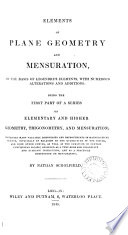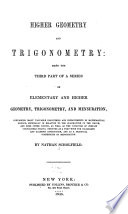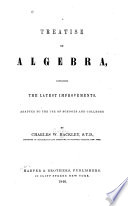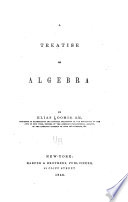 | Charles Davies - Surveying - 1839 - 376 pages
...equal to the quotient obtained by dividing the numerator by the denominator, its logarithm will be equal to the logarithm of the numerator minus the logarithm of the denominator. Therefore, log VoV=l°g 3678 — log 100 = 3.565612 — 2 = 1.565612 from which we see, that a mixed... | |
 | Charles Davies - Navigation - 1835 - 388 pages
...equal to the quotient obtained by dividing the numerator by the denominator, its logarithm will be equal to the logarithm of the numerator minus the logarithm of the denominator. Therefore, log VlV=log »878 — log 100 = 3.565012 — 2 = 1.565612 from which we see, that a mixed... | |
 | Nathan Scholfield - 1845 - 894 pages
...is equal to the sum of the logarithms of these factors. II. Divide equation (1) by (2), N_o*_ N'~^ The logarithm of a fraction, or of the quotient of...both members of equation (1) to the power of n. Nn =a" .-. by def. (2), nx is the logarithm of N ", that is to say, The logarithm of any power of a given... | |
 | Nathan Scholfield - Conic sections - 1845 - 542 pages
...Divide equation (1) by (2), N=£_ N' c? N .•. def. (2), x— x1 is the logarithm of that is to say, The logarithm of a fraction, or of the quotient of...Raise both members of equation (1) to the power of n. N" =a" „•. by def. (2), nx is the logarithm of N ", that is to say, The, logarithm of any power... | |
 | Charles William Hackley - Algebra - 1846 - 542 pages
...is to say, Tlie logarithm of a fraction, or of the quotient oftimnumbers, is equal to the logaritlim of the numerator minus the logarithm of the denominator. III. Raise both members of equation (1) to the nth power. N"=a". .-. by definition, nx is the logarithm of N° ; that is to say, The logarithm of... | |
 | Charles William Hackley - Algebra - 1846 - 544 pages
...II. Divide equation (1) by (2). .•. by definition, x — z7 is the logarithm of ^ ; that is to say, The logarithm of a fraction, or of the quotient of two numbers, is equal to the logaritfim of the numerator minus the logarithm of the denominator. III. Raise both members of equation... | |
 | Charles William Hackley - Algebra - 1846 - 542 pages
...by (2). N_o« N'=o" =a'-". .•. by definition, x — x1 is the logarithm of ^r; ; that is to say, The logarithm of a fraction, or of the quotient of two numbers, is equal to On: logarithm of the numerator minus the logarittim of the denominator. III. Raise both members of... | |
 | Elias Loomis - Algebra - 1846 - 376 pages
...that is to say, The logarithm of a fraction, or of the quotient of one, number divided by another, is equal to the logarithm of the numerator' minus the logarithm of the denominator. Hence we see that if we wish to divide one number by another, we have only to subtract the logarithm... | |
 | Elias Loomis - Algebra - 1846 - 380 pages
...; that is to say, The logarithm of a fraction, or of the quotient of one number divided by another, is equal to the logarithm of the numerator, minus the logarithm of the denominator. Hence we see that if we wish to divide one number by another, we have only to subtract the logarithm... | |
 | Charles William Hackley - Algebra - 1847 - 546 pages
...II. Divide equation (1) by (2). N .-. by definition, x — x" is the logarithm of ^ ; that is to say, The logarithm of a fraction, or of the quotient of...denominator. III. Raise both members of equation (1) to the nth power. N"=a". .-. by definition, nx is the logarithm of N° ; that is to say, The logarithm of... | |
| |